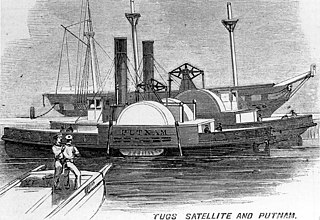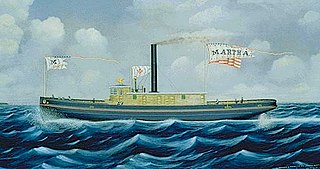
CSS Albemarle was a steam-powered casemate ironclad ram of the Confederate Navy, named for an estuary in North Carolina which was named for General George Monck, the first Duke of Albemarle and one of the original Carolina Lords Proprietor.
USS Alert was a 90 long tons (91 t) steamship named A. C. Powell purchased by the Union Navy during the first year of the American Civil War.

USS Jacob Bell was a sidewheel steamer acquired by the Union Navy for use during the American Civil War. She was one of the oldest vessels so acquired. Her duties included river patrols, guard duty, and other duties as assigned.

USS Valley City was a 190-ton steamer acquired by the Union Navy for service in the American Civil War.
USS Zouave was a steamer acquired by the Union Navy during the American Civil War. She was needed by the Navy to be part of the fleet of ships to prevent blockade runners from entering ports in the Confederacy.

USS General Putnam – also known as the USS William G. Putnam – was acquired by the Union Navy during the first year of the American Civil War and outfitted as a gunboat and assigned to the Union blockade of the Confederate States of America. She also served as a tugboat and as a ship's tender when so required.
USS Lilac was a steamer acquired by the Union Navy during the American Civil War. She was used by the Navy as a tugboat and in other minor roles.
USS Cowslip was a steamer acquired by the Union Navy during the American Civil War.
USS Martin was a steamer acquired by the Union Navy during the American Civil War. She was used by the Union Navy for various tasks, including those of a torpedo boat, tugboat, and a picket boat, patrolling Confederate waterways to prevent the South from trading with other countries.
USS Belle was a steamer acquired by the Union Navy during the American Civil War.

USS Massasoit was a steamer purchased by the Union Navy during the American Civil War.
USS Stepping Stones was a steamer purchased by the Union Navy during the early part of the American Civil War.

USS Bazely was a steamer acquired by the Union Navy during the American Civil War. She was used by the Union Navy in a tugboat/patrol boat role in support of the Union Navy blockade of Confederate waterways.
USS Zeta was a steamer acquired by the Union Navy during the American Civil War. She was used by the Union Navy as a torpedo boat in support of the Union blockade of Confederate waterways.
USS Alpha was a side wheel paddle steamer acquired by the Union Navy during the American Civil War.
USS George W. Rodgers was a schooner captured by the Union Navy during the American Civil War. She was initially intended to be used as part of the stone fleet of sunken obstructions; however, she was retained and used as a picket boat and dispatch vessel and, later, as a survey ship, concentrating her efforts in the waterways of the Confederate South.
USS Poppy was a steamer commissioned by the Union Navy during the American Civil War.
USS Shokokon was a large (709-ton) steamer with powerful 30-pounder rifled guns, purchased by the Union Navy during the beginning of the American Civil War.

USS Violet was a 166-ton steamer acquired by the U.S. Navy for use during the American Civil War.

The Squib class torpedo boats were built for the Confederate States Navy during the later stages of the American Civil War. After the torpedo boat CSS David attacked and damaged the ironclad USS New Ironsides, the Confederates continued building torpedo boats with hopes of breaking the Union blockade. Four vessels of the class – CSS Hornet, CSS Wasp, CSS Squib, and CSS Scorpion – were constructed in Richmond, Virginia, in 1864. All were armed with a single spar torpedo and were powered by steam engines. Squib damaged the gunboat USS Minnesota in an attack on April 9, 1864, and was later sent to Wilmington, North Carolina, where she was scuttled in February 1865. The other three vessels of the class were all part of the James River Squadron and participated in the Battle of Trent's Reach on the night of January 23 and 24, 1865. Scorpion ran aground during the battle, and was forced downriver and out of control after the tender CSS Drewry exploded on January 24. She was later captured by Union forces and may have been burned. Hornet was sunk in a collision with another vessel on January 27, and Wasp was scuttled on the night of April 2/3, as the Confederates were abandoning Richmond.







